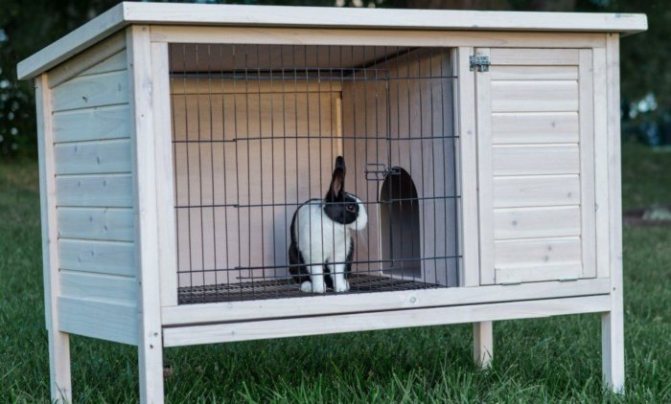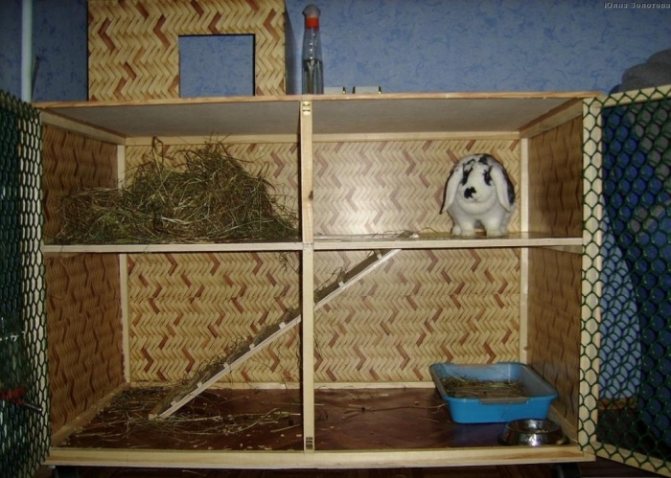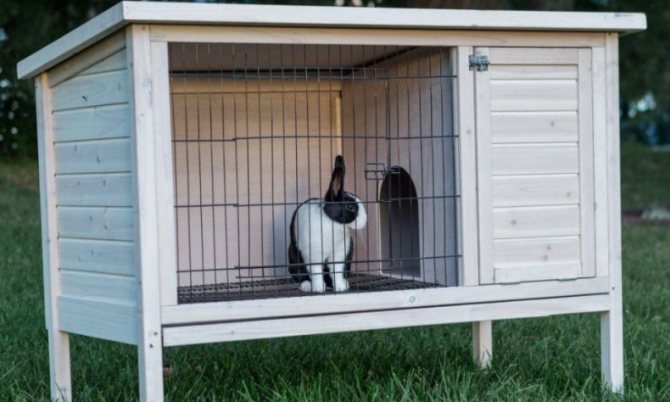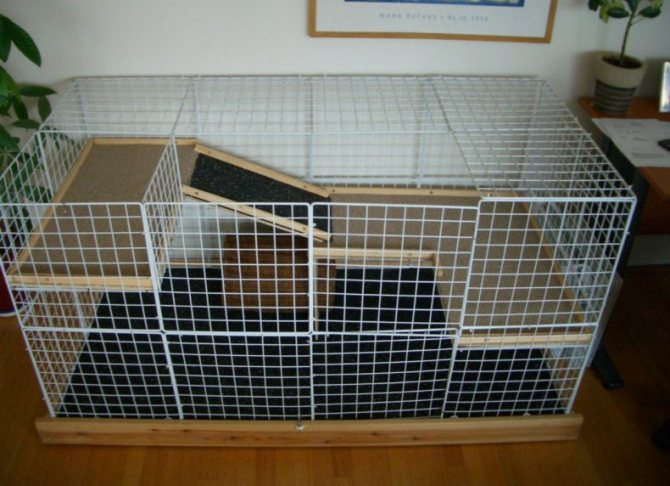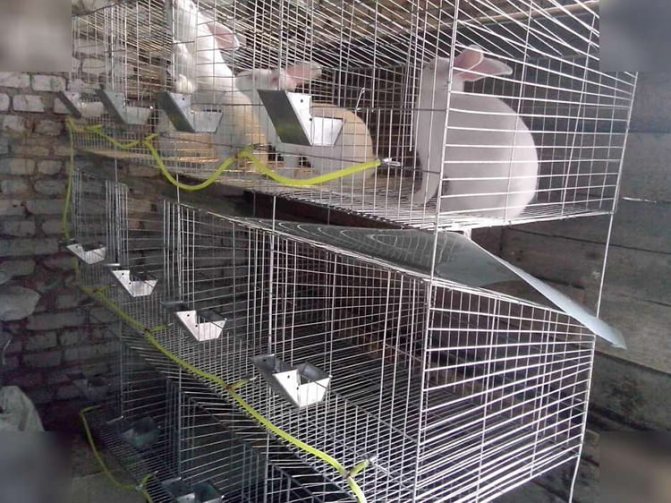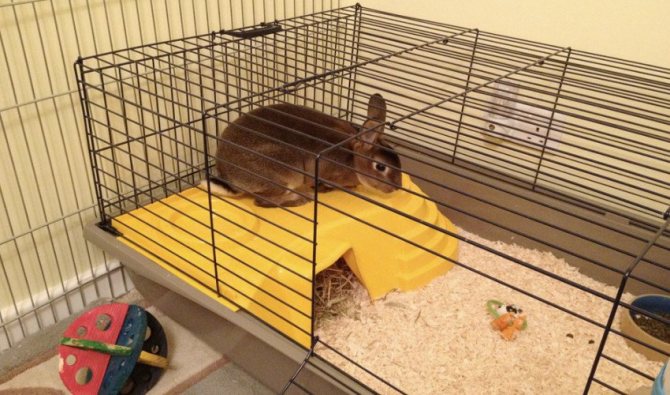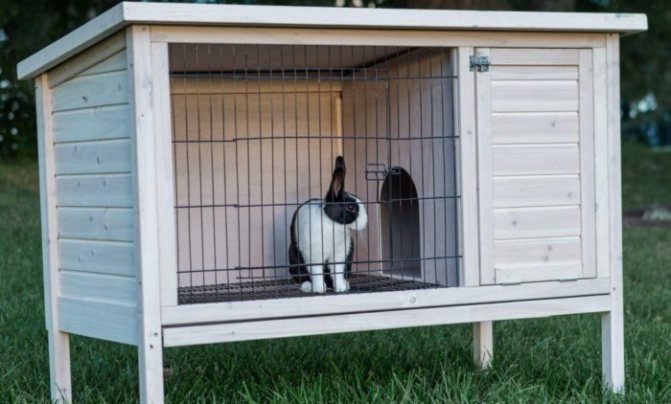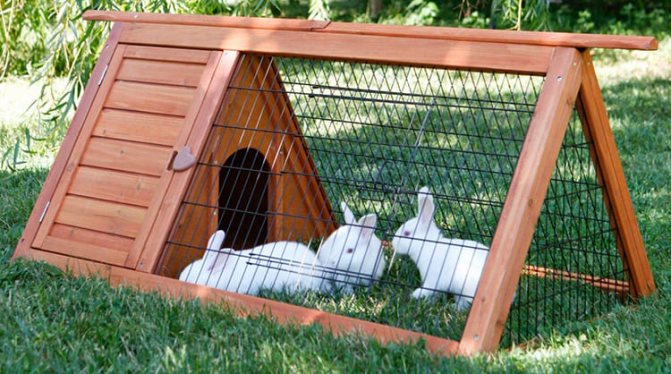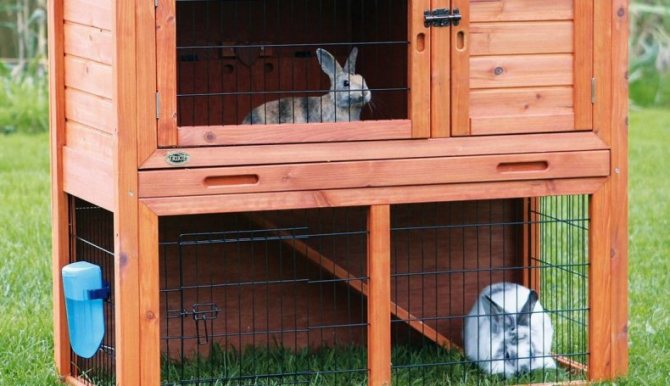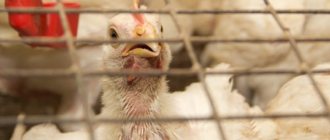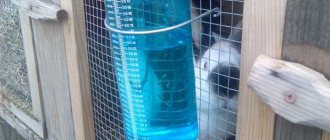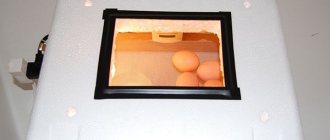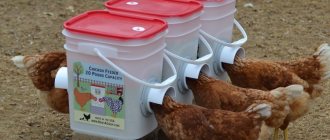Why not make the rabbits' home not only functional, but also beautiful? An excellent solution to this issue was demonstrated by the interior designer from the Netherlands, Evelyn Lulofs, who made a cage for his pets from a cheap kitchen cabinet.
Let's see how to transform an IKEA kitchen cabinet into a beautiful indoor rabbit cage. Follow our instructions and you can easily make a cage for a decorative rabbit with your own hands.
Features of the
Initially, it is necessary to determine the size of the future pet habitat. It should be about four times the size of the animal itself. It is not difficult to determine if the dwelling is spacious enough, knowing the approximate size of the animal. It is very important that the eared person can easily move around the house without restricting movement. If there is not enough space in the house, then the rabbit can get deformation of the entire skeleton, internal organs, or obesity.
The height of the cage for decorative rabbits should be such that the pet can safely stand on its hind legs.
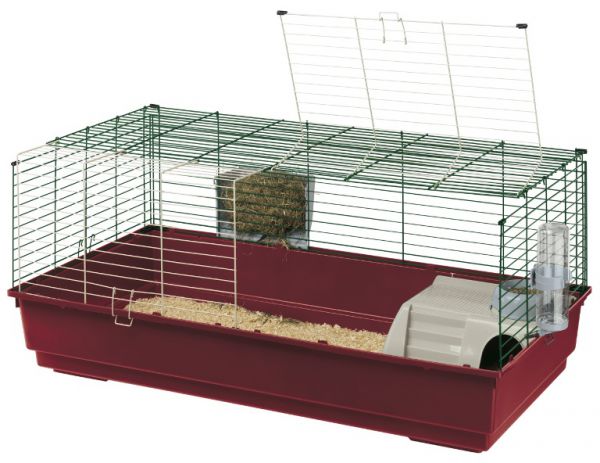
According to the standard, the length of the cage should be at least 1 meter, in width - approximately 45-60 cm. Remember, the more spacious the dwelling for the animal, the more comfortable it will be there. Also, decorative rabbits really like it if the house has floors (or as they are also called levels). If the pet will spend enough time outside the home, then you can make a 70x40 cm cage with your own hands.However, in this case, the main condition will be that the rabbit goes out for 3-4 hours a day for a walk around the house.
The floor in the dwelling should not be hard, as this can lead to inflammation on the rabbit's hind legs. Also, you should not put a grate on the bottom of the dwelling, because then the animal will not be comfortable. The fact is that these animals do not have pads on their paws, as, for example, other representatives of domestic fauna. If the cage has a mesh bottom, then it is best to put a soft rug or boards. Moreover, until the pet gets accustomed to the litter box, it will be among its garbage and waste, and this leads to various diseases.


Additionally, you can lay on the bottom of the cage not only a rug, but also shredded paper, sawdust of wood. And in order to make it easier to clean the home of a decorative rabbit, any dense material must be spread under them. Be sure to have a secluded place in the long-eared dwelling. It can even be an ordinary box or a house.
Also, do not forget about the mandatory cellular attributes: a drinker, a feeder, a house. The presence of a place to sleep is necessary, especially at first, while the animal gets used to a new place and unfamiliar people. The feeder and drinker should be made of heavy material. Or you need to make sure that they are firmly fixed, since these animals, while playing, can throw objects up.
Manufacturing
Pet stores offer cages for domestic rabbits for every taste, so even with a modest budget, you can find a home for your pet. But making it with your own hands will not be difficult. This will be even the best option, since the owner will be able to accurately follow all the recommendations and rules for the safety and comfort of his pet.


Tools and materials
- cell drawing;
- nails;
- plywood sheets (chipboard) - we take the quantity based on the size of the cage 90x60x45 cm;
- self-tapping screws;
- sheet metal - 90x60 cm, up to 0.2 mm thick;
- wooden slats;
- metal mesh - width 60 cm, height - 45 cm;
- hinges for doors;
- a hammer;
- file;
- scissors for cutting metal.
Step-by-step instruction
- We draw a drawing of the future dwelling for the animal or we take a ready-made one, as we suggest.


Drawing of a homemade rabbit cage - We start building the cage from the floor. We take a sheet of chipboard and cut it with a file. The size of the cut is 90x60 cm. You can make the cage smaller or larger, depending on the breed of your pet.
- On the plywood we put a sheet of tin of the same dimensions, up to 0.2 mm thick. Tin is optional, but it significantly simplifies the process of cleaning the cage.
- We cut pieces of plywood for the walls: height - 45 cm, width - 60 cm. If the dwelling for the rabbit is two-tier, then one side and back wall should be made of chipboard, and the rest - from a metal mesh. We fasten them together with nails, attach them to the floor with self-tapping screws.
- We make a door from wooden slats and mesh. Approximate size - 30x30 cm. Hang on the loops.
- We make the second tier of plywood, fasten it with self-tapping screws to the walls of the dwelling. Make sure the floor is stable and can support the rabbit's weight.
- We make a staircase at least 15 cm wide, using plywood and wooden slats for this. To do this, every 5 cm we hammer the slats on the chipboard with a hammer.
- We fix the feeder and drinker. They can be purchased.
- We equip the cage according to the recommendations indicated above.
It must be remembered that when building a cage with your own hands, you should not paint the walls of a small animal's home with paints or varnishes. Animals love to gnaw everything that comes their way, and any wall coating is toxic.
Features of the
Initially, it is necessary to determine the size of the future pet habitat. It should be about four times the size of the animal itself. It is not difficult to determine if the dwelling is spacious enough, knowing the approximate size of the animal. It is very important that the eared person can easily move around the house without restricting movement. If there is not enough space in the house, then the rabbit can get deformation of the entire skeleton, internal organs, or obesity.
The height of the cage for decorative rabbits should be such that the pet can safely stand on its hind legs.
According to the standard, the length of the cage should be at least 1 meter, in width - approximately 45-60 cm. Remember, the more spacious the dwelling for the animal, the more comfortable it will be there. Also, decorative rabbits really like it if the house has floors (or as they are also called levels). If the pet will spend enough time outside the home, then you can make a 70x40 cm cage with your own hands.However, in this case, the main condition will be that the rabbit goes out for 3-4 hours a day for a walk around the house.
The floor in the dwelling should not be hard, as this can lead to inflammation on the rabbit's hind legs. Also, you should not put a grate on the bottom of the dwelling, because then the animal will not be comfortable. The fact is that these animals do not have pads on their paws, as, for example, other representatives of domestic fauna. If the cage has a mesh bottom, then it is best to put a soft rug or boards. Moreover, until the pet gets accustomed to the litter box, it will be among its garbage and waste, and this leads to various diseases.
Additionally, you can lay on the bottom of the cage not only a rug, but also shredded paper, sawdust of wood. And in order to make it easier to clean the home of a decorative rabbit, any dense material must be spread under them. Be sure to have a secluded place in the long-eared dwelling. It can even be an ordinary box or a house.
Another popular option for building a rabbit house
Decorative rabbits love space, and it is important for their owner to provide them with it. In search of a solution to the problem of where to find a suitable corner for these animals, some things and pieces of furniture that have not been used for their intended purpose for a long time can help. One of these is a wooden table. If somewhere in the country, in the pantry or in the shed there is this unnecessary item, he should be given a second life.
The novice breeder was lucky if he managed to get a rectangular or square table with four legs. Its structure already has the necessary wooden supports, which will serve as a frame for the structure, as well as a cover (tabletop). The only thing left for a person is:
- Strengthen the structure of the future house with the missing wooden lintels. The bar is screwed to the table legs with self-tapping screws.
- Screw the awnings for the future door to the table leg.
- Cover the structure with a mesh.
It is not necessary to round the table with a net. If the pet's house is located against a wall, one side of it can be sheathed with boards or plywood. The same actions are carried out with the doorway. Each pet owner can choose a convenient and economical version of the model of the future structure.
A table cage has many advantages. One of them is ease of cleaning. In order to clean the floor in the house, you just need to move it. And if linoleum is used as the basis of the litter, it will also be easy to get out from under the table to wash and dry in the sun.
Manufacturing
Pet stores offer cages for domestic rabbits for every taste, so even with a modest budget, you can find a home for your pet. But making it with your own hands will not be difficult. This will be even the best option, since the owner will be able to accurately follow all the recommendations and rules for the safety and comfort of his pet.
Tools and materials
- cell drawing;
- nails;
- plywood sheets (chipboard) - we take the quantity based on the size of the cage 90x60x45 cm;
- self-tapping screws;
- sheet metal - 90x60 cm, up to 0.2 mm thick;
- wooden slats;
- metal mesh - width 60 cm, height - 45 cm;
- hinges for doors;
- a hammer;
- file;
- scissors for cutting metal.
Step-by-step instruction
- We draw a drawing of the future dwelling for the animal or we take a ready-made one, as we suggest. Drawing of a homemade rabbit cage
- We start building the cage from the floor. We take a sheet of chipboard and cut it with a file. The size of the cut is 90x60 cm. You can make the cage smaller or larger, depending on the breed of your pet.
- We put a sheet of tin of the same dimensions on plywood, up to 0.2 mm thick. Tin is optional, but it significantly simplifies the process of cleaning the cage.
- We cut pieces of plywood for the walls: height - 45 cm, width - 60 cm. If the dwelling for the rabbit is two-tier, then one side and back wall should be made of chipboard, and the rest - from a metal mesh. We fasten them together with nails, attach them to the floor with self-tapping screws.
- We make a door from wooden slats and mesh. Approximate size - 30x30 cm. Hang on the loops.
- We make the second tier of plywood, fasten it with self-tapping screws to the walls of the dwelling. Make sure the floor is stable and can support the rabbit's weight.
- We make a staircase at least 15 cm wide, using plywood and wooden slats for this. To do this, every 5 cm we hammer the slats on the chipboard with a hammer.
- We fix the feeder and drinker. They can be purchased.
- We equip the cage according to the recommendations indicated above.
It must be remembered that when building a cage with your own hands, you should not paint the walls of a small animal's home with paints or varnishes. Animals love to gnaw everything that comes their way, and any wall coating is toxic.
Features of the
Initially, it is necessary to determine the size of the future pet habitat. It should be about four times the size of the animal itself. It is not difficult to determine if the dwelling is spacious enough, knowing the approximate size of the animal.It is very important that the eared person can easily move around the house without restricting movement. If there is not enough space in the house, then the rabbit can get deformation of the entire skeleton, internal organs or obesity.
The height of the cage for decorative rabbits should be such that the pet can safely stand on its hind legs.
According to the standard, the length of the cage should be at least 1 meter, in width - approximately 45-60 cm. Remember, the more spacious the dwelling for the animal, the more comfortable it will be there. Also, decorative rabbits really like it if the house has floors (or as they are also called levels). If the pet will spend enough time outside the home, then you can make a 70x40 cm cage with your own hands.However, in this case, the main condition will be that the rabbit goes for 3-4 hours a day for a walk around the house.
The floor in the dwelling should not be hard, as this can lead to inflammation on the rabbit's hind legs. Also, you should not put a grate on the bottom of the dwelling, because then the animal will not be comfortable. The fact is that these animals do not have pads on their paws, as, for example, other representatives of domestic fauna. If the cage has a mesh bottom, then it is best to put a soft rug or boards. Moreover, until a pet gets accustomed to the litter box, it will be among its garbage and waste, and this leads to various diseases.
Additionally, you can lay on the bottom of the cage not only a rug, but also shredded paper, sawdust of wood. And in order to make it easier to clean the home of a decorative rabbit, it is necessary to spread any dense material under them. Be sure to have a secluded place in the long-eared dwelling. It can even be an ordinary box or a house.
Also, do not forget about the obligatory cellular attributes: a drinker, a feeder, a house. The presence of a place to sleep is necessary, especially at first, while the animal gets used to a new place and unfamiliar people. The feeder and drinker should be made of heavy material. Or you need to make sure that they are firmly fixed, since these animals, while playing, can throw objects up.
Manufacturing
Pet stores offer cages for domestic rabbits for every taste, so even with a modest budget, you can find a home for your pet. But making it with your own hands will not be difficult. This will be even the best option, since the owner will be able to accurately follow all the recommendations and rules for the safety and comfort of his pet.
Tools and materials
- cell drawing;
- nails;
- plywood sheets (chipboard) - we take the quantity based on the size of the cage 90x60x45 cm;
- self-tapping screws;
- sheet metal - 90x60 cm, up to 0.2 mm thick;
- wooden slats;
- metal mesh - width 60 cm, height - 45 cm;
- hinges for doors;
- a hammer;
- file;
- scissors for cutting metal.
Step-by-step instruction
- We draw a drawing of the future dwelling for the animal or we take a ready-made one, as we suggest. Drawing of a homemade rabbit cage
- We start building the cage from the floor. We take a sheet of chipboard and cut it with a file. The size of the cut is 90x60 cm. You can make the cage smaller or larger, depending on the breed of your pet.
- We put a sheet of tin of the same dimensions on plywood, up to 0.2 mm thick. Tin is optional, but it significantly simplifies the process of cleaning the cage.
- We cut pieces of plywood for the walls: height - 45 cm, width - 60 cm. If the dwelling for the rabbit is two-tier, then one side and back wall should be made of chipboard, and the rest - from a metal mesh. We fasten them together with nails, attach them to the floor with self-tapping screws.
- We make a door from wooden slats and mesh. Approximate size - 30x30 cm. Hang on the loops.
- We make the second tier of plywood, fasten it with self-tapping screws to the walls of the dwelling. Make sure the floor is stable and can support the rabbit's weight.
- We make a staircase at least 15 cm wide, using plywood and wooden slats for this.To do this, every 5 cm we hammer the slats on the chipboard with a hammer.
- We fix the feeder and drinker. They can be purchased.
- We equip the cage according to the recommendations indicated above.
Do-it-yourself rules for making a cage for a decorative rabbit
02If you decide to get a decorative rabbit, he will need a cage in which he will live. You can buy ready-made, especially since there is a wide selection in stores. But a spacious dwelling will cost you a pretty penny, and in a small cage the pet will not be able to feel good. In this situation, one way out is to make a cage with your own hands. The material is much cheaper to buy than a ready-made cage, and no special knowledge is required to construct it.
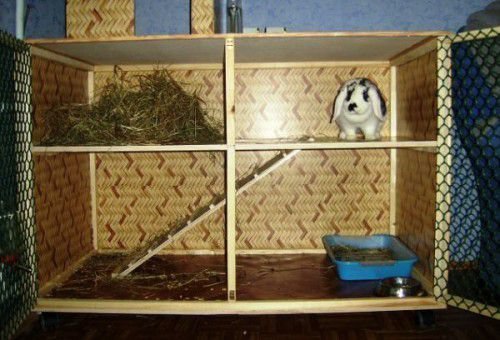

Rabbit in a homemade cage
Cage dimensions
Before you buy material for building a cage for decorative rabbits, you need to know what size the dwelling should be. According to the rules, it is 4 times larger than a rabbit, so that he can move freely on it. An economical option is 1 meter long and 60 cm wide. The height is selected so that the animal can stand on its hind legs. You can make it larger, then the pet will be especially comfortable in it. A cage of 50 x 100 cm or 50 x 80 cm is allowed. The height is 40-45 cm if the house is two-tier, and 50 cm if it is one-story. It is important to remember that the animal should not be in such a room around the clock, let it walk for at least 2-3 hours.
If you decide to make housing for a decorative rabbit more compact, the animal will not be able to move in it. Then he will have serious health problems: obesity, deformation of internal organs and skeleton.
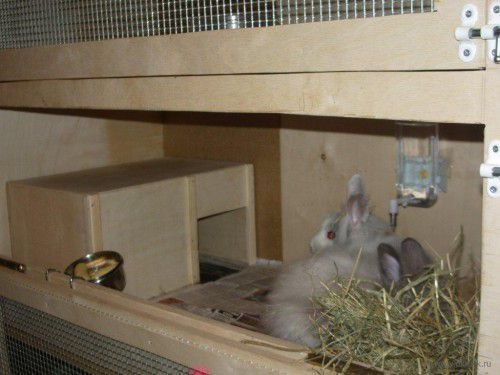

The rabbit should not be cramped
Maintenance and care of the cage
Cleanliness in a cage is the key to the health and comfort of its inhabitant. In order for the care of the rabbit's home not to turn into hard labor, everything must be done on time and rationally.
Three things require daily attention:
Leftover feed should be removed from the trough, then simply rinsed well under running water and dried before re-filling with content.
The drinking bowl is washed in the same way and filled with fresh water.
For regular maintenance of the tray, you just need to change the filler, after rinsing the container with warm water (you should not pour new filler into the wet tray, but you can use a hair dryer for accelerated drying).
Periodically, as far as possible, it is necessary to devote a little more time to the tray, removing the plaque of urine that accumulates on its walls.
Citric acid works well for this, but you can also use 9% table vinegar or apple cider vinegar.
Cage care. If its inhabitant is accustomed to a litter box and if you do not use a litter, the cage can be cleaned quite rarely, sometimes it is enough to carry out a general cleaning once a month, but it all depends on the condition of the dwelling.
Another secret: with all the thoroughness of the cleaning, it is imperative to leave a small area unprocessed, because rabbits, just like cats and dogs, mark their territory (they do this through a special gland on their chin).
Remember which area you left unwashed, and next time clean it especially carefully, and leave another area untouched instead.
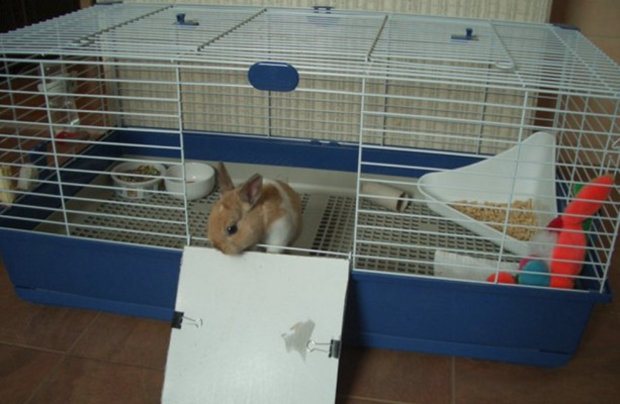

Cleaning the cage involves thoroughly washing the pallet (if it is plastic) and completely treating all the rods with a disinfectant solution.
The easiest way to do this is to use table vinegar. Dilute it with water in a 1: 1 ratio, moisten a cloth with the resulting solution and thoroughly wipe all structural elements. Do not forget to wipe the pallet after washing, after which you can assemble the house and run the tenant into it again.
Making a cage for a decorative rabbit on your own is not an easy task. But if you show a little ingenuity, patience and effort, everyone can solve it.And the reward for the time spent will be the affection from watching the cozy fuss of a fluffy pet, happily settling in a new home.
60
What you need to know about the cage
Those who want to build a cage with their own hands should know the features of decorative rabbits so as not to make common mistakes.
- No slatted floor. Decorative rabbits have no pads on their paws, which distinguishes them from cats or dogs. Therefore, they cannot live on the floor - the lattice. If you nevertheless made such a cage by mistake, you will have to constantly lay a board, a carpet so that the animal sits on them. If you do not, the rabbit will constantly be in the toilet, as the only suitable surface for it.
- Do not varnish or paint. Rabbits love to chew on everything. To prevent them from being poisoned by harmful substances, it is better not to paint or varnish the cage.
- The bottom of the cage is with bedding. If pets live on a hard surface, then their hind legs will become inflamed. Therefore, the bottom of the cage is sprinkled with either sawdust, or paper, or a soft rug is laid. To keep the sawdust from spilling out, do not forget about the thresholds. But it is better not to use carpet as a bedding. it is harmful material if it is chewed, but rabbits will. But if you make a second floor out of it, securing it with nails so that it does not get ripped off, this material is also good.
- The material is durable. These animals are constantly gnawing. Therefore, it is important to choose a durable material.
General content issues


Photographed near flowers
Regardless of the species, they do not tolerate heat, they need good nutrition and fresh air. The danger to their health is low or high humidity, drafts.
Professional advice
Buy a home made of high quality durable materials. Then she will serve the breeder for at least 3 years. The rabbit, in 100% of cases, will begin to gnaw on the rods. The bars or lattice should not be painted (galvanized, metal can be used), otherwise the paint will cause diseases.
It is undesirable to buy a cage made of plastic, since it is completely closed, and the rabbit is literally frying in it, suffering from lack of air. It is important to have a first aid kit and a carrier. Purchase small clippers, a mineral stone, a brush to brush and a vegetable holder.
Briefly and to the point. Look to gain an understanding of the arrangement and maintenance of dwarf and ornamental breeds:
https://youtu.be/XXTYHu0Tk7A
Since these animals are public, it is desirable for them to create a company. But here it is worth considering that two males will not be able to live together because of the constant struggle for territory. Get two females. Individuals of different sexes will get along only if the male is castrated. It is important to increase the length of the cage by 20 cm. Rabbits are not hamsters!
House from an old table
If you already have an old and unnecessary medium-sized table in your house or dacha, instead of carrying it to the trash heap, use it to make a cage with your own hands.
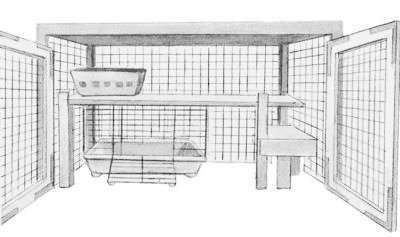

Diagram of a cage from an old table
Attach wooden frames to the legs of this table, onto which the net would be stretched. Make sure that there are no protruding ends of the wire and the tips of the nails, otherwise the pet will get hurt. It is not necessary to attach only the mesh, the back wall is made of plywood. Hang the two frames from the front on the door hinges. These are the doors.
You don't have to do the bottom to make it easier to clean, but lay a piece of linoleum underneath.
Preparation of materials and inventory
For the manufacture of a structure at home, boards, chipboard, plexiglass, nets are suitable. To glue surfaces, glue with a harmless composition is selected. For greater strength, furniture fittings are used. You will need nails, screws, and door hinges. Special slats should be purchased. They frame the housing outside, and also make a staircase and a bridge.
You should not use plastic or plastic, otherwise your pet will be uncomfortable. These materials do not absorb moisture, but retain an unpleasant odor and require daily maintenance. They are capable of poisoning animals if they gnaw them.
Required inventory:
- a hammer;
- hacksaw;
- screwdriver;
- scissors for metal.
():
Resourceful owners sometimes construct a dwelling for a future pet from old furniture. For this, an old cabinet, chest of drawers, shelves may be suitable. But first they are nevertheless put in order, the surface is processed and the details necessary for the comfortable existence of the rabbit are completed.
Step-by-step instruction
If you are planning to make a cage with your own hands, then you can follow this instruction. Such a cage does not require any skill or skill.
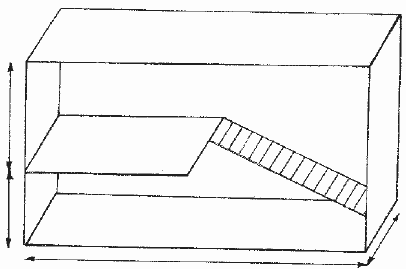

Simple cell diagram
This dwelling is not distinguished by an interesting design, but the pet will be cozy and comfortable in it.
- First draw a drawing or use a ready-made one.
- Make the floor. To do this, take a sheet of chipboard and cut it to a size of 90 x 60 cm. If you have a spacious apartment, make the cage larger and choose different sizes.
- A piece of tin. Prepare a sheet of tin, like chipboard, 0.2 mm thick. You can do without tin, but it will make it easier for you to clean your home.
- We make the side walls. They will need pieces of chipboard 45 cm high and 60 cm wide. If the house is built only from plywood, the rabbit will be dark. Therefore, only the back and side walls are made of chipboard. For the rest, it is better to use frames with a stretched metal mesh, which they also do by hand. If you take the net, debris will fall from the floor of the cage: sawdust, paper. The walls are fastened with nails, and then fastened to the floor using self-tapping screws.
- We make a door. To make a door, you will need a mesh and wood slats. Hang it on the hinges.
- Second tier. We fasten a sheet of plywood to create the second tier to the walls using self-tapping screws. The floor is stable and must support the weight of the animal so that the rabbit does not fall or get hurt.
- Stairs. The pet can get to the second floor using the stairs. You will also have to do it yourself. The width of the ladder is at least 15 cm. It is also constructed from plywood and slats. At 5 cm intervals, hammer the wood strip onto the chipboard.
This is not the only option for creating a cell with your own hands. Turn on your imagination, creativity, and build something interesting.
Original rabbit cage
It is not necessary to use plywood. Plexiglass houses for a rabbit are very convenient. This is an inexpensive material that will be easy to wash and clean later. Plexiglas sheets are either glued together with pet-safe glue or attached with furniture fittings. Then such a cage with a rabbit should not be left in direct sunlight.
A do-it-yourself cage is both saving money and creating a cozy and comfortable home for your pet. If you think over all the details in advance and approach the work responsibly, the pet will like its home.
This is also very important because it is stress for an animal - moving to a new home. Therefore, it is better to immediately prepare suitable housing and leave the rabbit in it. If he previously lived in a small house, place it inside the new home to reduce the stress of the move. Luxurious apartments are a guarantee that the rabbit will live a long and happy life next to you, and will not suffer in a small box.
What is better to make
Let us dwell in more detail on those materials that are preferable to use when creating a cell with our own hands, and consider their positive and possible negative sides.
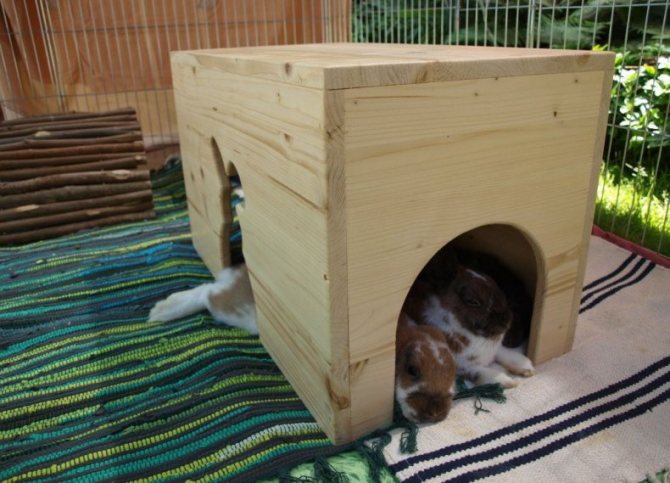

A sheet of ordinary plywood or chipboard is best suited for flooring. If you want to make your pet's home as environmentally friendly as possible, then you should use a solid board (not glued, since the adhesive material is often toxic).
Read also: Why does the rabbit grunt and breathe heavily
Metal nets or rods as a floor covering, as already mentioned, cannot be used - your pet simply will not be able to move on them. It is recommended to sprinkle a layer of sawdust on top of the wooden floor, which will become an excellent natural and environmentally friendly substrate for bedding.
So, there are several options for building materials that are suitable for cage flooring: wooden board, plywood, chipboard or OSB, plexiglass, plastic.
Solid wood plank has a number of advantages over other materials, namely:
- strength and durability;
- environmental Safety;
- non-slip coating;
- pleasant appearance (which is important when the cage will be in your house).
Among the disadvantages of the board can be distinguished:
- the need for additional machining to remove burrs, burrs and other irregularities;
- in the absence of varnishing (and this cannot be done to ensure the safety of rabbits), the tree will still be traumatic, because driving a splinter on such a floor is as easy as shelling pears.
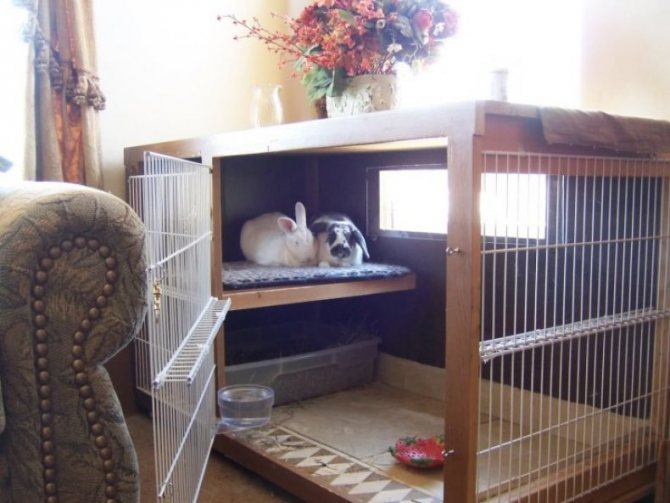

Otherwise, solid wood will be a great natural material for a cage floor.
Particleboard or OSB will be alternative materials for flooring. They have approximately the same positive aspects, except for environmental safety, because these building materials contain chemical adhesives, which pushes chipboard and OSB to second place.
Plexiglass is also a very interesting and relatively inexpensive material. But its slippery coating will not fit well with the paws of fluffy animals, and therefore it is better not to use such material for the floor of the cage. It may work for walls or ceilings, but not for floors.
Plastic has excellent characteristics in use, but it cannot be classified as an environmentally friendly material, since it is all a product of chemical processing. Although in the care of plastic there is no equal - it is very easy to clean, and you will not have to remove the burrs from the tender paws of rabbits.
If we talk about the material that is best suited for the walls, then wooden blocks will be the best solution. They will serve as a good, strong and reliable frame. And from the inside they can be closed with a metal mesh, which is sold in hardware stores. Such a mesh will perform a deterrent function so that the pet cannot freely walk around the apartment, and also provide ventilation, which is also very important for small fur-bearing animals.


Another option for the walls is plexiglass, which we talked about earlier, but you will have to drill a lot of ventilation holes in it, and this will add extra work. Therefore, in choosing the optimal, safe and durable material for the walls, we recommend environmentally friendly solid wood beams, to which a metal mesh is attached.
DIY dwarf rabbit cage
Decorative or, as they are also called, dwarf rabbits often become favorites of children and adults. These animals are very unpretentious, they do not cause trouble for their owner, do not require special care. In order for a rabbit to feel good in a new home, even before buying a small animal, you need to take care of a cage for it.
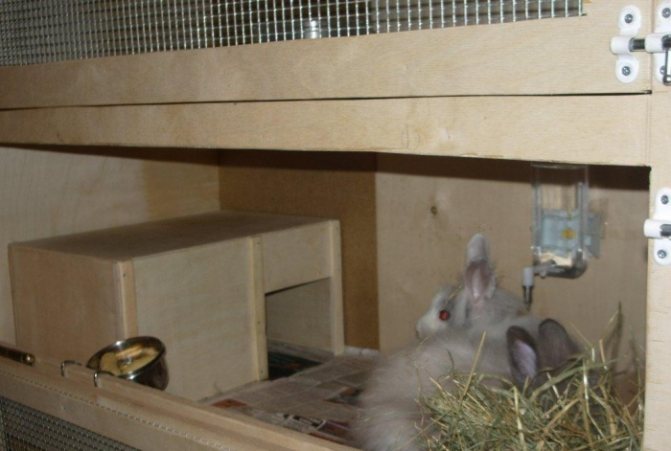

Unfortunately, the cost of a cage at pet stores can scare off the most ardent animal lover. Ordinary houses made of plastic or wood cost "space" money. What to do if you really want to have a decorative rabbit, but there is not enough money for a cage? You can easily build it yourself.
Features and habits of dwarf rabbits
Dwarf rabbits are cute fluffy animals. In order for the cage to become a real home for them, in which the animal will feel like a master, you need to learn about the preferences of this animal.


First of all, rabbits need space.No matter how chic and large the cage is, a decorative animal must be released from it at least once a day. Ideally, such a walk in time is about 1.5-2 hours.
That is why a cage for a dwarf rabbit should be spacious enough, because the animal will spend most of its life in it. The standard dimensions for a house are 1000x600 mm.
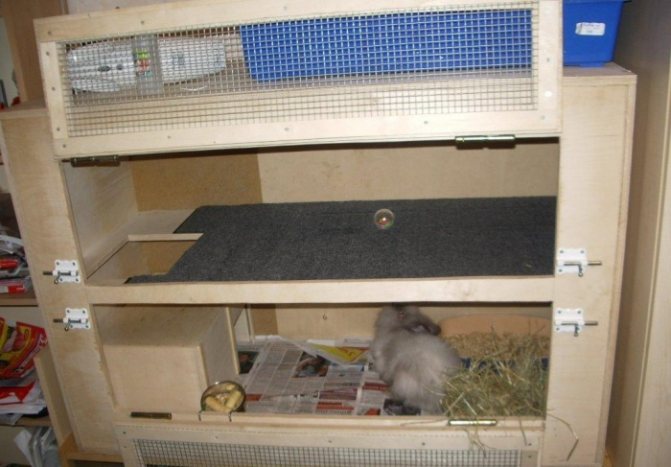

However, this figure is not suitable for everyone - there are many breeds of decorative animals, and one of their differences is size. There are very tiny animals, and there are rabbits, whose weight reaches two kilograms. Therefore, when building a cage, it is better to proceed from the dimensions of the animal itself - the ideal house should be at least four times the size of the inhabitant.


The second quality of a rabbit is cleanliness. This animal not only loves cleanliness, it really feels bad in unsanitary conditions. The immunity of rabbits is very weak, any viruses, bacteria, fungi cause serious diseases in pets that are difficult to treat.
Therefore, the pet cage must be very clean. The floors in the house should be cleaned at least once a week, and the plates and drinkers should be washed every three days.
Another quality of rabbits is speed. These animals move very quickly, can jump high, so they need to be protected from injury. All parts and materials of the cage must be safe: no sharp corners, no toxic materials.
Given these features of decorative rabbits, you can build the best house in which the animal will feel safe.
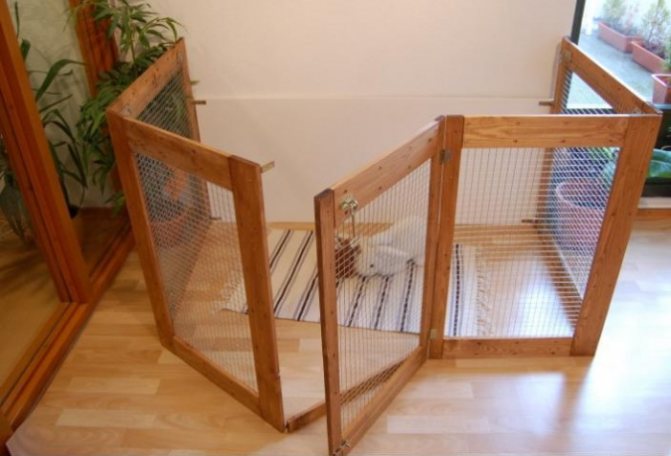

Requirements for keeping rabbits
The second quality of a dwarf rabbit is its cleanliness. This is homemade the animal feels very bad in unsanitary conditions... Any bacteria, viruses, fungi cause various serious diseases in rabbits that are difficult to treat. To increase immunity, a pet needs to be vaccinated against various diseases in a timely manner.
Cleaning is best done with hot water, and disinfection with a solution of potassium permanganate. Cell drying is best done outdoors in sunny weather to kill any remaining germs.
Rabbits are very clean animals, but the owner will have to devote a lot of time to caring for the fur of his pet. She will need at least combing, and long-haired breeds also need to be cut regularly.
Cage design
A cage for a decorative rabbit can have any design, be equipped with special "furniture" and accessories, and be a work of art.
But, in fact, the animal does not need expensive interior details and a chic construction with a penthouse. An ordinary rectangular cage is enough for a decorative rabbit, the main thing is that it is dry, spacious and clean.
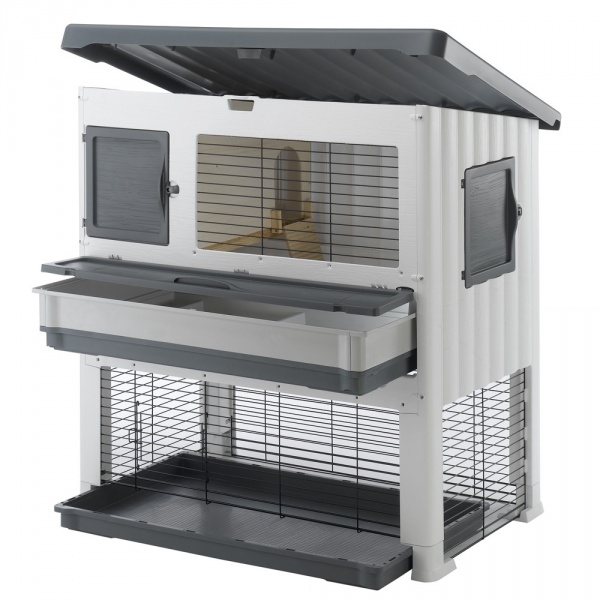

And building a simple house with your own hands is much easier than building "fantasy" palaces. Here's everything you need to build a solid cage:
- plywood or fiberboard sheet;
- several wooden slats;
- fine mesh metal mesh;
- fasteners (nails, screws);
- door hinges.
Rabbits are very fond of "floors" and various ladders, because these animals need to move a lot. Therefore, you can build a two-tier cage, especially since it is not at all difficult to do this.
Another required attribute is a ladder. It is made as a crossbar between floors, or the floor and the roof of the "bedroom" are connected by means of a staircase.
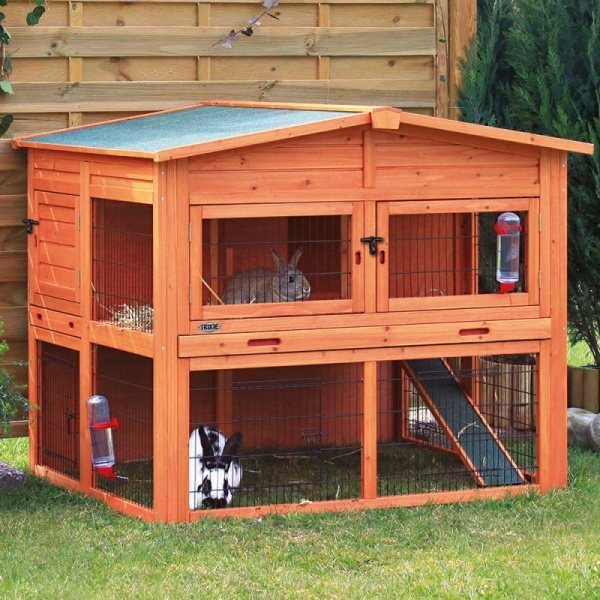

Whatever the design of the cage, the rabbit should be comfortable and spacious in it. All "furniture" and decor should be freely located inside, without interfering with the animal or injuring it.


Any cell must contain:
- bowls for food and a drinker, which must be fixed so that the pet cannot rip them off and turn them over;
- "Bedroom" in the form of a small house made of wood or other material, where the animal can rest and hide;
- ladder to provide the movement necessary for the rabbit;
- toilet - a tray or a separate corner on the floor of the cage, which must be lined with sawdust or paper torn into pieces;
- a door through which the animal can go for a walk.
Arrangement of the finished house


Ready house for a rabbit
When the construction work has come to an end, you need to equip a cage for a decorative rabbit. A rest house and a tray are placed inside. A pet toilet is installed in the corner on the lower level if the cage is two-tier.
Attention! The rabbit himself will choose a place for the toilet when for the first time he goes to one of the corners in need. This is where the tray should be placed.
The cage is equipped with a drinker and a manger for hay, as well as a container for compound feed. If desired, you can attach the feeder to one of the walls of the dwelling to prevent contamination of the feed and overturning of dishes.
The floor should be covered with a mat. It is used as sawdust, paper or hay. A special filler is poured into the tray. To keep your pet from getting bored, it is worth purchasing several toys for it - a maze or mats. Playing with them, the eared eared will become more mobile, which will have a beneficial effect on his health.
The cage for a decorative rabbit must not be placed in the sun or in a draft. These animals are very sensitive and demanding of keeping conditions. It is also important to take into account the fact that the animal is not stressed, therefore it is better to place its dwelling in the quietest room in the house.
Building a cage for a rabbit with your own hands is not so difficult. If you are smart, it can be made from old furniture - a sideboard or table, metal mesh and a sheet of plywood. At minimal cost, it is easy to make a comfortable and spacious home for your pet.
How to build a rabbit cage


The simplest cage can be assembled in a matter of minutes. All that is needed is to adhere to the drawn up drawing and step by step perform the following steps:
- Examine the selected drawing, familiarize yourself with the dimensions and method of connecting parts.
- Cut a rectangle from a sheet of plywood or fiberboard with a hacksaw, the dimensions of which coincide with the perimeter of the cage floor.
- It is better to cover the wood with thin tin. The thickness of the sheet should not exceed 0.2 mm, gently bend the edges of the sheet metal so that the animal cannot get hurt. Tin is necessary to simplify the cleaning process of the cage, it is much easier to wash it than moisture-absorbing wood.
- Cut out the back wall and one of the sides from plywood or fiberboard. If all sides of the cage are made of wood, the rabbit will be too dark, it can get sick from lack of sunlight.
- Connect the bottom and walls with self-tapping screws. It is imperative to ensure that the fasteners do not protrude anywhere and cannot injure the rabbit.
- Attach a fine-mesh mesh to the wooden slats with nails or self-tapping screws.
- Connect the sidewall to the rest of the structure.
- Attach the hinges to the door and hang it on the side walls.
- Install a ceiling for the second floor, having previously cut it out of plywood and upholstered with tin.
- Mount the ladder by connecting two floors. To make a ladder, planks are stuffed onto the board in steps of 3-5 cm.
- Install a house for a rabbit, bowls, and a drinking bowl inside the cage. Fix everything so that the animal cannot play with them.
- Install the roof. Any material can be used as a roof, it can be the same plywood or lattice. It is better to make the roof removable, this will greatly simplify the cleaning process. It is also better not to fasten the overlap of the second floor "tightly", but, at the same time, it must calmly support the weight of the rabbit and not topple over.
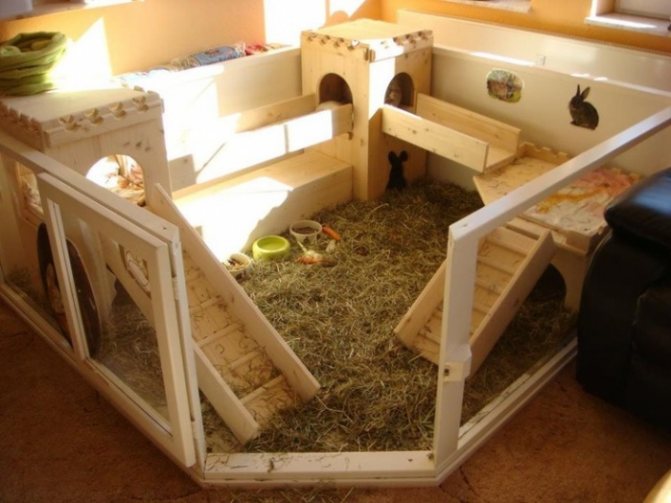

It is important to remember that rabbits love to nibble on anything that comes their way. Therefore, the materials for the cage must be environmentally friendly - the rabbit will definitely try them on the tooth.
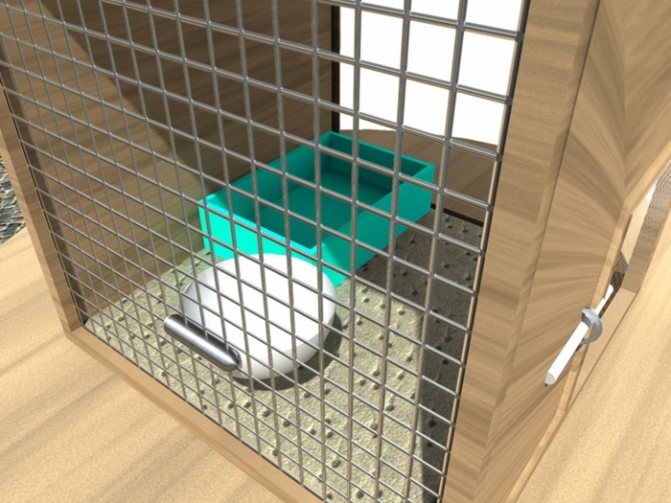

For the same reason, the cage cannot be painted or varnished; eating them, the animal may be poisoned. There is no need to make a house for a rabbit made of plastic or plastic, in such a house the animal will be stuffy and uncomfortable.
You need to choose environmentally friendly and natural materials. A good choice is plexiglass. Such a cage will not become food for the rabbit, at the same time, it will allow enough light and air to pass through. You just need to know that plexiglass cells cannot be placed in direct sunlight - the material can get very hot in the sun.
Installation
The cage is placed in the apartment so that it does not interfere with the free movement of residents. It is placed away from heating appliances, TV. Direct sunlight should not fall on the plexiglass house. The place should be well ventilated, drafts are not allowed.
():
Do not place the cage against a wall. Rabbits will be happy to gnaw wallpaper and any coverings. Also, in the nearest availability, in no case should there be wires.
It is better to install the structure on the floor, then the animal can go for a walk on its own. When the house is ready, all the items necessary for keeping the rabbits are installed in it. The feeder is located on the opposite side of the drinker. A hay nursery is set up 15 cm above the floor.


